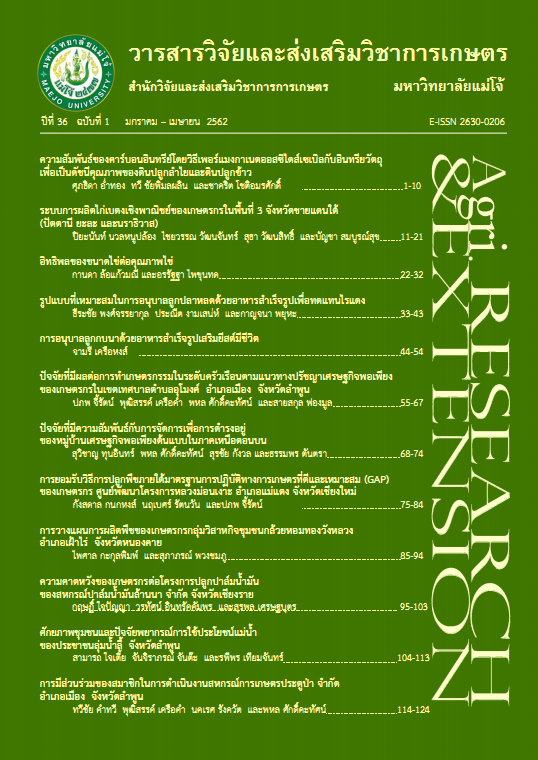ความสัมพันธ์ของคาร์บอนอินทรีย์โดยวิธีเพอร์แมงกาเนตออสซิไดส์เซเบิลกับอินทรียวัตถุ เพื่อเป็นดัชนีคุณภาพของดินปลูกลำไยและดินปลูกข้าว
คำสำคัญ:
ดินปลูกข้าว, ดินปลูกลำไย, เพอร์แมงกาเนตออกซิไดส์เซเบิลคาร์บอน, อินทรียวัตถุในดินบทคัดย่อ
งานวิจัยนี้มีวัตถุประสงค์เพื่อศึกษาผลของดินปลูกข้าวและดินปลูกลำไยต่อปริมาณอินทรียวัตถุในดิน (Soil Organic Matter; SOM) และคาร์บอนอินทรีย์ที่ย่อยสลายง่ายโดยวิธีเพอร์แมงกาเนตออสซิไดส์เซเบิล (Permanganate Oxidizable Carbon; POXC) ที่นำไปสู่ความสัมพันธ์ของ SOM และ POXC เพื่อเป็นดัชนีชี้วัดคุณภาพดิน วางแผนการทดลองแบบ Factorial in Randomized Complete Block Design (RCBD) โดยมี 2 ปัจจัย ซึ่งปัจจัยที่ 1 คือ พื้นที่ศึกษา ได้แก่ อำเภอแม่แตง สันทราย ดอยสะเก็ด พร้าว และสารภี ปัจจัยที่ 2 คือ รูปแบบการใช้ที่ดิน ได้แก่ ดินปลูกข้าวและดินปลูกลำไย ผลการศึกษาพบว่า ค่าเฉลี่ยปริมาณ SOM, POXC และความหนาแน่นรวมของดิน (Bulk density; Bd) ของดินปลูกลำไยมีค่าร้อยละ 2.65, 1.0976 ก./กก. และ 1.22 ก./ลบ.ซม. สูงกว่าดินปลูกข้าวที่มีค่าร้อยละ 2.45, 1.0797 ก./กก. และ 1.14 ก./ลบ.ซม. ตามลำดับ ความสัมพันธ์ระหว่าง SOM กับ POXC ในดินปลูกข้าวจากพื้นที่ของ 5 อำเภอ มีค่าสัมประสิทธิ์สหสัมพันธ์ (r) ใกล้เคียงกัน ในขณะที่ความหนาแน่นรวมของดิน (Bd) ของอำเภอแม่แตงมีค่ามากที่สุด SOM เป็นคาร์บอนอินทรีย์ส่วนหนึ่งที่ได้จากการย่อยสลายของเศษซากวัสดุอินทรีย์ มีองค์ประกอบคาร์บอนที่เป็นส่วนที่ย่อยสลายยากและส่วนที่ย่อยสลายง่าย (POXC) ทำให้สรุปได้ว่าดินปลูกพืชที่มีการไถพรวนอย่างรุนแรงและการใส่ปุ๋ยเคมีเพียงอย่างเดียวเป็นตัวเร่งการย่อยสลาย SOM ของดิน ทำให้ได้ส่วนของ POXC ซึ่งเป็นดัชนีตัวชี้วัดที่สำคัญที่มีผลต่อคุณภาพของดิน และควรมีการพัฒนาชุดตรวจ POXC เพื่อเป็นค่าชี้วัดคุณภาพดินในระดับภาคสนามต่อไป
เอกสารอ้างอิง
Aumtong, S., J. Magid, S. Bruun and A.de. Neergaard. 2009. Relating soil carbon fractions to land use in sloping uplands in northern Thailand. Agriculture, Ecosystems and Environment 131(3-4): 229-239.
Aumtong, S. and P. Pongwongkam. 2017. The amount and sequestration of organic carbon fractions in paddy soils. Journal of Agri. Research & Extension 34(2): 1-13.
Bray, R.H. and L.T. Kurtz. 1945. Determination of total, organic and available forms of phosphorus in soil. Soil Science 59: 39-45.
Baver, L.D., W.H. Gardner and W.R. Gardner. 1972. Soil Physics. 4th Edition. New York: John Wiley and Sons. 489 p.
Bi, L., S. Yan and B. Zhang. 2015. Impacts of long-term chemical and organic fertilization on soil. Soil and Tillage Research 152: 94-103.
Blair, G.J., R.D.B. Lefroy and L. Lisle. 1995. Soil carbon fractions based on their degree of oxidation and the development of a carbon management index for agricultural systems. Australian Journal of Agricultural Research 46: 1459-1466.
De Moraes Sá.J.C., D.R.P. Gonçalves,L.A. Ferreirac, U. Mishra, T.M. Inagaki, F.J.F. Furlan, R.S. Moro, N. Floriani, C. Briedis and A.de.O. Ferreira. 2018. Soil carbon fractions and biological activity based indices can be used to study the impact of land management and ecological successions. Ecological Indicators 84: 96-105.
Finn, D., K. Page, C. Ekaterina, S. MarcoKienzlea, F. Robertson, R. Armstong and R. Dalal. 2015. Effect of added nitrogen on plant litter decomposition depends on initial soil carbon and nitrogen stoichiometry. Soil Biology and Biochemistry 91: 160-168.
Isaac, R.A. and J.D. Kerber. 1971. Atomic Absorption and Flame Photometry: Techniques and Uses in Soil, Plant and Water Analysis. pp. 17-37. In Walsh, L.M. (ed). Instrumental Methods for Analysis of Soil and Plant Tissues. Madison: SSSA.
Islam, M.R., P.S. Chauhan, Y. Kim, M. Kim and T.M. Sa. 2011. Community level functional diversity and enzyme activities in paddy soils under different long-term fertilizer management practices. Biology and Fertility of Soils 47(5): 599-604.
Mc Lean, E.O. 1982. Soil pH and Lime Requirement. pp. 199-224. In Page A.L. (ed). Methods of Soil Analysis, Part II. Chemical and Microbiological Properties. Madison: Soil Science Society of America.
Mueller, T., L.S. Jensen, N.E. Nielsen and J. Magid. 1998. Turnover of carbon and nitrogen in a sandy loam soil following incorporation of chopped maize plants, barley straw and blue grass in the field. Soil Biology and Biochemistry 30(5): 561-571.
Office of Agricultural Economics. 2016. Agricultural Statistics of Thailand in 2016. [Online]. Available www.oae.go.th/download/download_journal/2560/yearbook59.pdf (12 February 2018).
Sriwichai, W. 2018. Emission Quantity and Formation of Greenhouse-carbon Gases in Different Textural Paddy Soils Receiving Biochar and Rice Straw:
Case Study of Pot Experiment and Soil Incubation. Master dissertation. Khon Kaen University. 81 p.
Sriwichai, W., D. Tulaphitak, P. Lawongsa and P. Saenjan. 2018. Soil organic carbon and stable carbon locations in different textural paddy soils. Khon Kaen Agr. J. 46(3): 483-488.
Tisdall, J.M. and J.M. Oades. 1982. Organic matter and water-stable aggregates in soils. Journal Soil Science 33(2): 141-163.
Walkley, A. 1947. A critical examination of a rapid method for determination of organic carbon in soils effect of variations in digestion conditions and of inorganic soil constituents. Soil Science 63(4): 251-257.
Weil, R.R., K.R. Islem, M.A. Stien, J.J. Gruver and S.E. Samson-Liebig. 2003. Estimate active carbon for soil quality assessment: a simplified method for laboratory and field use. American Journal of Alternative Agriculture 18(1): 1-17.
Yan, X., H. Zhou, Q.H. Zhu, X.F. Wang, Y.Z. Zhang, X.C. Yu and X. Peng. 2013. Carbon sequestration efficiency in paddy soil and upland soil under long-term fertilization in southern China. Soil and Tillage Research 130: 42-51.
ดาวน์โหลด
เผยแพร่แล้ว
รูปแบบการอ้างอิง
ฉบับ
ประเภทบทความ
สัญญาอนุญาต
ลิขสิทธิ์ (c) 2019 วารสารวิจัยและส่งเสริมวิชาการเกษตร

อนุญาตภายใต้เงื่อนไข Creative Commons Attribution-NonCommercial-NoDerivatives 4.0 International License.
บทความนี้ได้รับการเผยแพร่ภายใต้สัญญาอนุญาต Creative Commons Attribution-NonCommercial-NoDerivatives 4.0 International (CC BY-NC-ND 4.0) ซึ่งอนุญาตให้ผู้อื่นสามารถแชร์บทความได้โดยให้เครดิตผู้เขียนและห้ามนำไปใช้เพื่อการค้าหรือดัดแปลง หากต้องการใช้งานซ้ำในลักษณะอื่น ๆ หรือการเผยแพร่ซ้ำ จำเป็นต้องได้รับอนุญาตจากวารสาร





